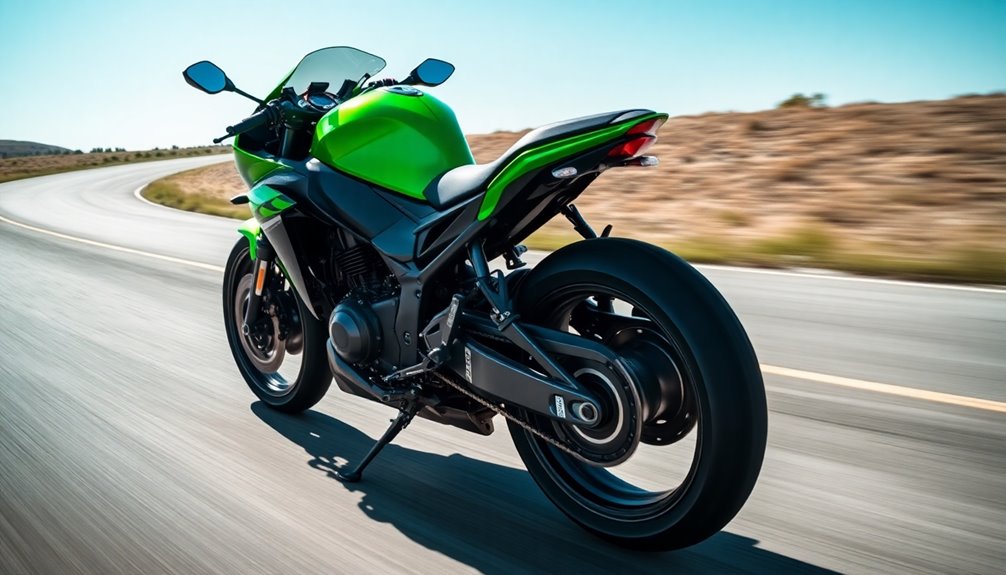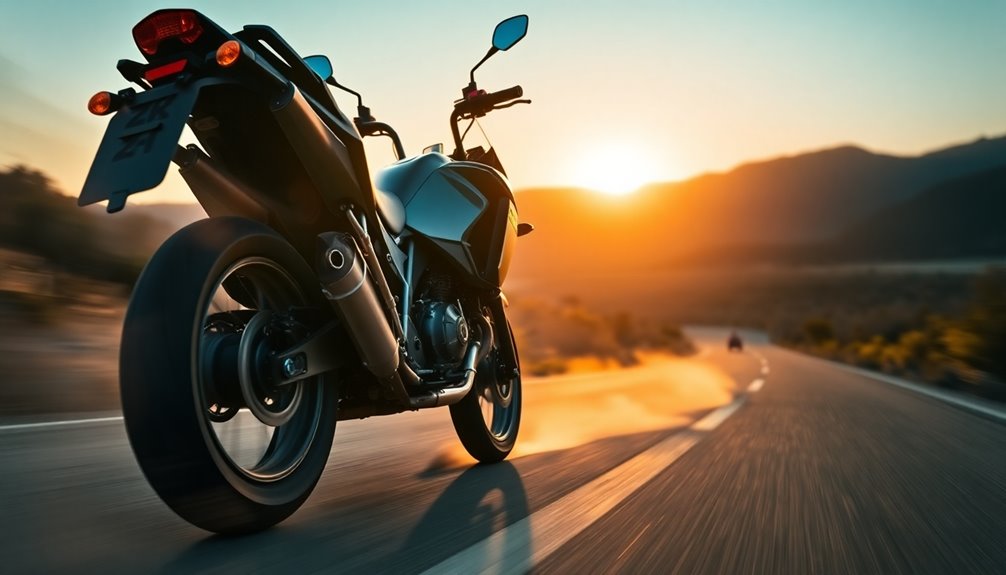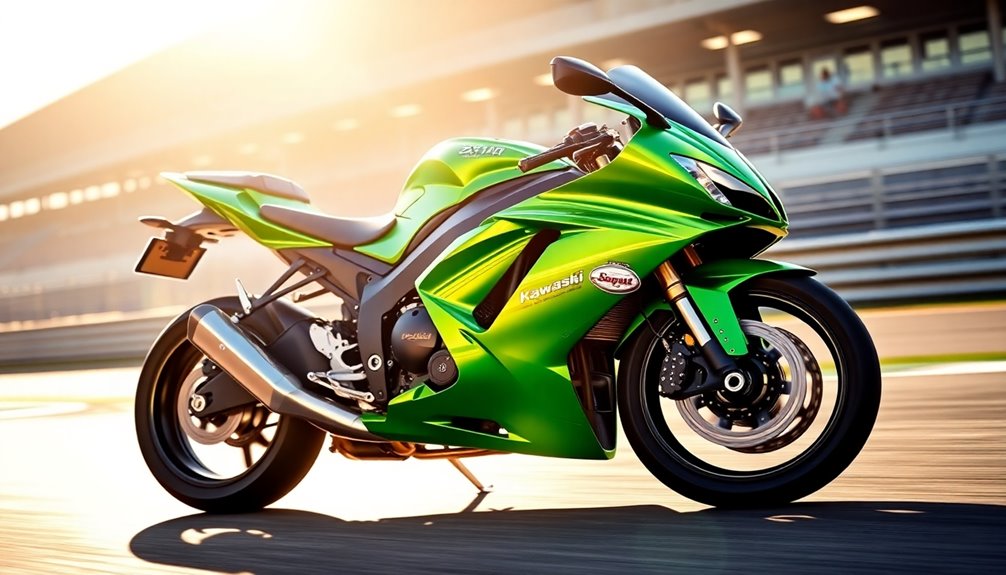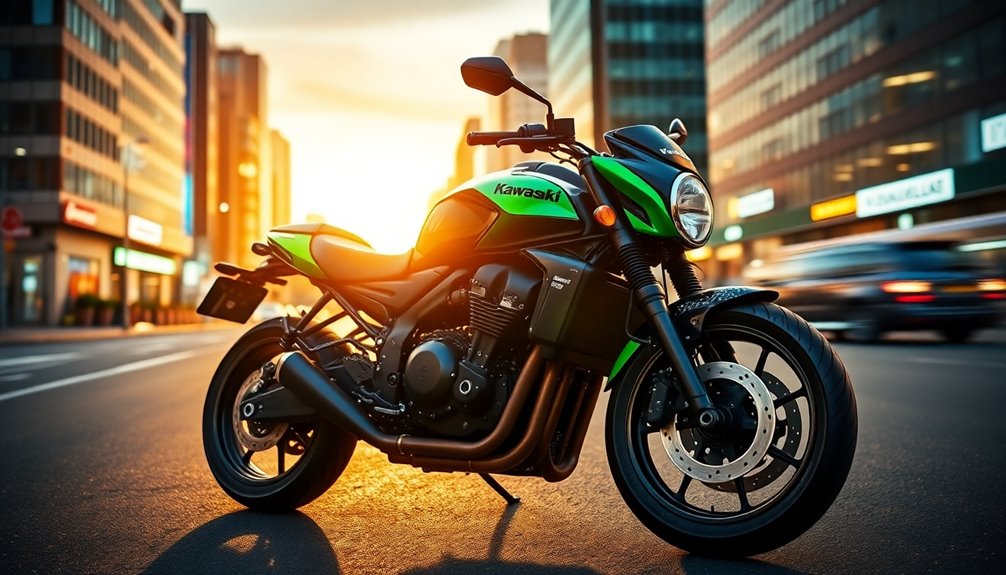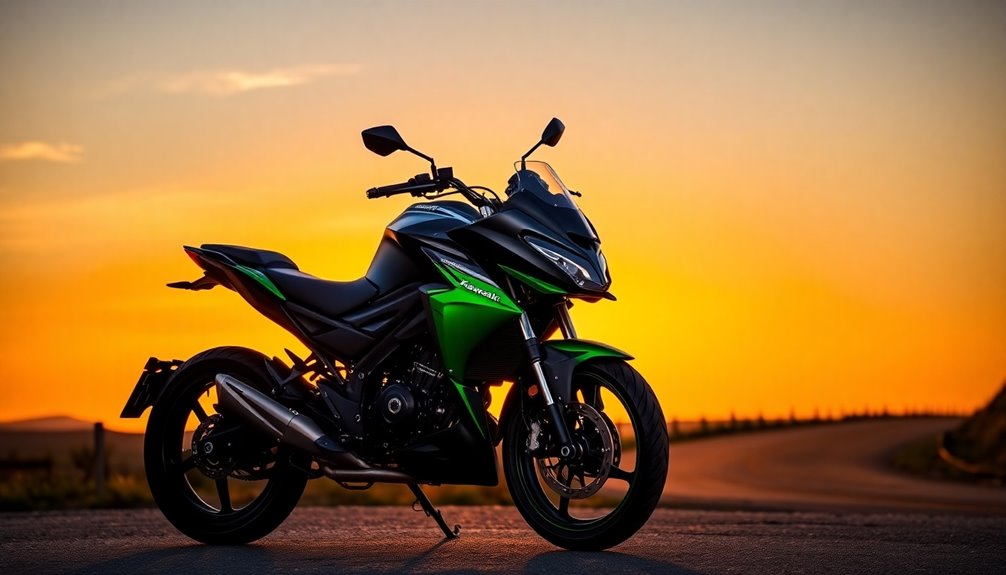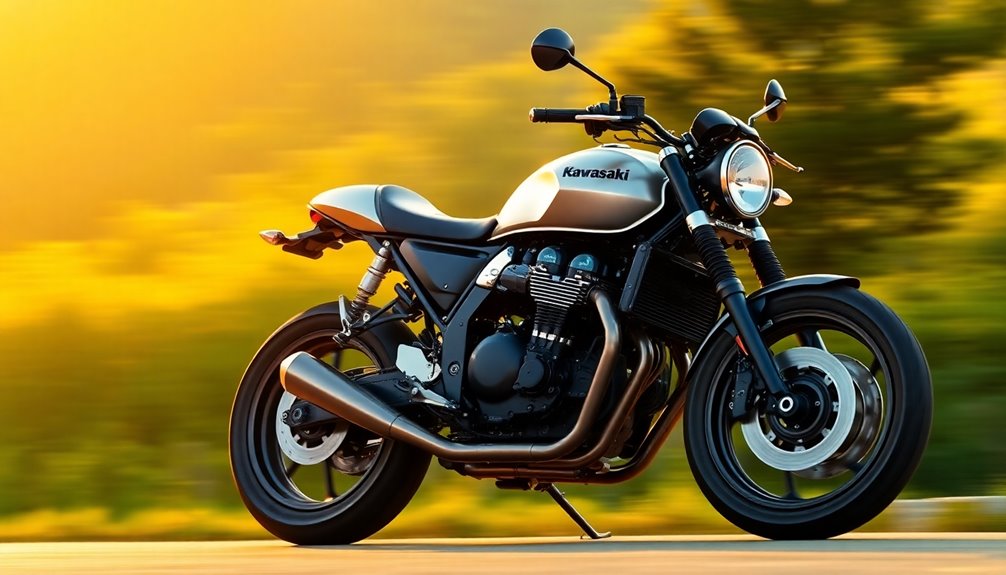The Kawasaki H2 combines forced induction with high-performance engineering to achieve an impressive top speed of 209 mph for the street-legal model. Its 998 cc liquid-cooled inline-four engine, featuring a unique two-speed supercharger, delivers 310 PS and 165 Nm of torque, enabling rapid acceleration. With its advanced aerodynamics and lightweight carbon-fiber construction, it maneuvers effortlessly at high speeds. Riders can enhance performance further with tuning options and modifications for even greater speed. If you're curious about its specifications and riding experiences, there's plenty more to discover about what makes the H2 a true powerhouse.
Key Takeaways
- The Kawasaki H2 achieves a top speed of 209 mph, with performance parts potentially increasing it to 226.9 mph.
- The unique two-speed centrifugal supercharger enhances the H2's acceleration and peak velocity, showcasing forced induction technology.
- Aerodynamic features, including carbon-fiber wings and a rear diffuser, contribute to stability at high speeds and improved performance.
- The inline-four engine design delivers linear power and rapid acceleration, with peak torque available at 12,500 rpm.
- With a curb weight of 238 kg, the H2's lightweight construction maximizes performance and maneuverability at extreme speeds.
Supercharged Inline-Four Engine
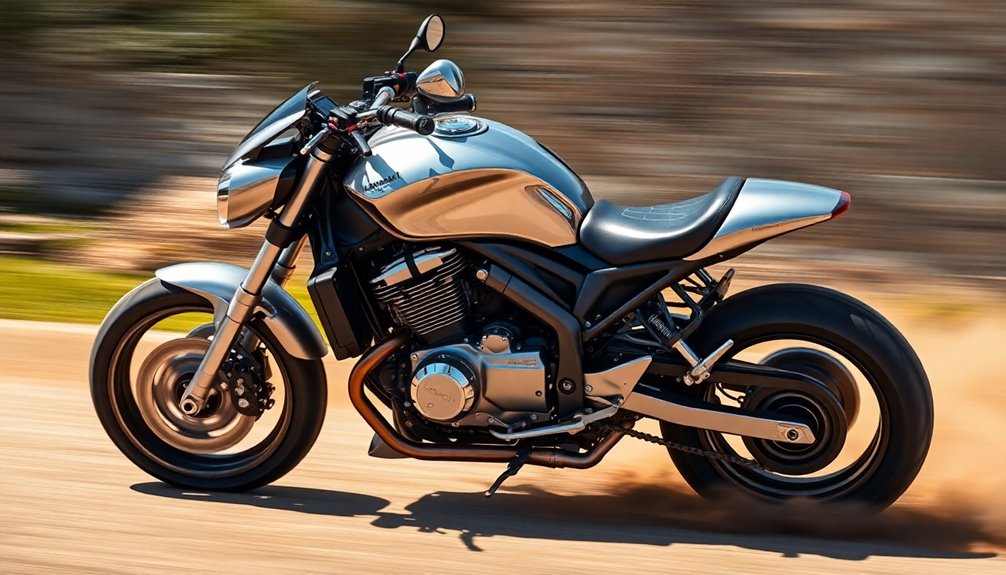
The Kawasaki H2's supercharged inline-four engine is a marvel of engineering that delivers exceptional power and performance. With a displacement of 998 cc, this liquid-cooled, 4-stroke engine features four cylinders, each equipped with four valves. The supercharger significantly enhances power delivery, ensuring you experience a thrilling ride every time you twist the throttle.
When you unleash the H2, you'll feel the surge of max power—310 PS at 14,000 rpm globally or 195 HP at 11,000 rpm in the USA and Canada. The engine generates an impressive torque of 165 Nm at 12,500 rpm globally, which translates to exhilarating acceleration. The H2 is built with a compression ratio of 8.3:1, enhancing its performance further.
The advanced induction system, featuring DFI® with 50mm throttle bodies and dual injection, complements the supercharger, optimizing performance across the rev range. Built to withstand extreme conditions, the H2 utilizes cast, flat-top pistons and knock sensors to prevent detonation.
Paired with a 6-speed manual transmission and hydraulic clutch, this engine's design ensures you harness its full potential seamlessly. Overall, the Kawasaki H2's supercharged inline-four engine sets a benchmark for high-performance motorcycles, promising an unforgettable riding experience.
Maximizing Engine Efficiency
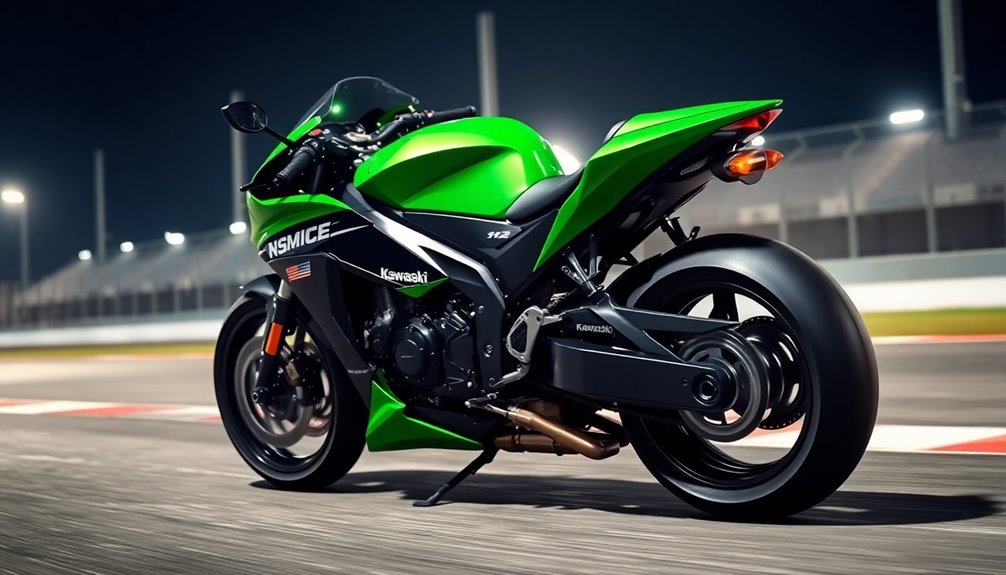
To maximize engine efficiency in the Kawasaki H2, you'll want to focus on peak velocity achieved and throttle response enhancement. Aerodynamic design considerations play a crucial role in reducing drag and improving overall performance. The integration of advanced technology from the MotoGP significantly enhances both transmission efficiency and overall power delivery.
Peak Velocity Achieved
Maximizing engine efficiency plays a crucial role in achieving the Kawasaki H2's impressive peak velocity. The heart of this powerhouse is its 998 cc 4-valve, dual overhead cam inline-4 engine, which features a unique two-speed centrifugal supercharger.
This supercharger, driven by a sophisticated system of gears and shafts, eliminates the need for an intercooler by maintaining minimal heat gain during air compression.
With an optimized high compression ratio, the engine delivers exceptional fuel efficiency and torque, ensuring that every drop of fuel translates into power. This efficiency extends across a wide range of pressure ratios and flow rates, providing strong acceleration and a stellar top speed of 209 mph for the street-legal Ninja H2.
When equipped with performance parts, the H2 can reach an astonishing 226.9 mph, while the H2R variant soars to a maximum speed of 240 mph. This remarkable performance is complemented by a balanced supercharged engine, maximizing power output at 200-210 hp and even more with ram-air.
Ultimately, the Kawasaki H2 showcases how advanced engineering and design culminate in extraordinary peak velocity, further exemplified by its top speed of approximately 249 mph, making it one of the fastest production motorcycles available.
Throttle Response Enhancement
Enhancing throttle response is essential for unlocking the full potential of the Kawasaki H2's performance. By implementing modifications like the G2 Tamer Throttle Tube, you'll notice a significant improvement in throttle control. This ramped design requires a slightly longer turn to reach the same throttle body opening, which reduces jerky responses that can be particularly frustrating on fuel-injected street bikes. Additionally, the G2 Throttle Tube is constructed from durable 6061 aluminum, ensuring longevity and optimal performance.
Additionally, tuning the Electronic Control Unit (ECU) is crucial. The chip tuning module adjusts the air-fuel mixture, optimizing combustion across different RPM ranges. At low RPMs, it enhances torque for smoother starts, while in the mid-range, it increases power output for better acceleration.
The integration of the supercharger and engine design also plays a key role in throttle response. The 998 cc inline-4 engine delivers linear power without significant heat gain, ensuring that you enjoy smooth acceleration throughout the entire RPM range.
Finally, the advanced fuel injection system works in harmony with these elements, providing precise amounts of fuel to match real-time air conditions. This synergy enhances overall engine efficiency, allowing for a more responsive and enjoyable riding experience.
Aerodynamic Design Considerations
Aerodynamic design plays a crucial role in maximizing the Kawasaki H2's engine efficiency and overall performance. The incorporation of carbon-fiber wings with angled winglets smooths airflow and generates downforce, enhancing stability at high speeds. The front spoiler and chin spoiler contribute to this downforce, allowing for better handling.
To further improve performance, a rear diffuser reduces wind resistance while maintaining control. The high-RPM supercharger significantly boosts power by compressing air, which is essential for achieving optimal engine output.
Airflow management is vital. The ram air duct directs fresh air to the supercharger efficiently, while a single ram air intake optimizes airflow to the engine. The supercharger's impeller features an optimized blade shape that maximizes airflow efficiency, crucial for high-performance output. Aerodynamically shaped cowls reduce resistance, aiding in cooling and performance.
Design innovations also focus on downforce generation, with technologies drawn from aviation to minimize air resistance. The overall design ensures high-speed stability, even beyond 300 km/h, by significantly reducing lift.
Lastly, the H2's construction emphasizes carbon-fiber for rigidity and low weight. This, combined with meticulous machining and a trellis frame structure, not only enhances performance but also rider comfort, making the Kawasaki H2 an engineering marvel on the road.
Rider Feedback: Thrilling Acceleration
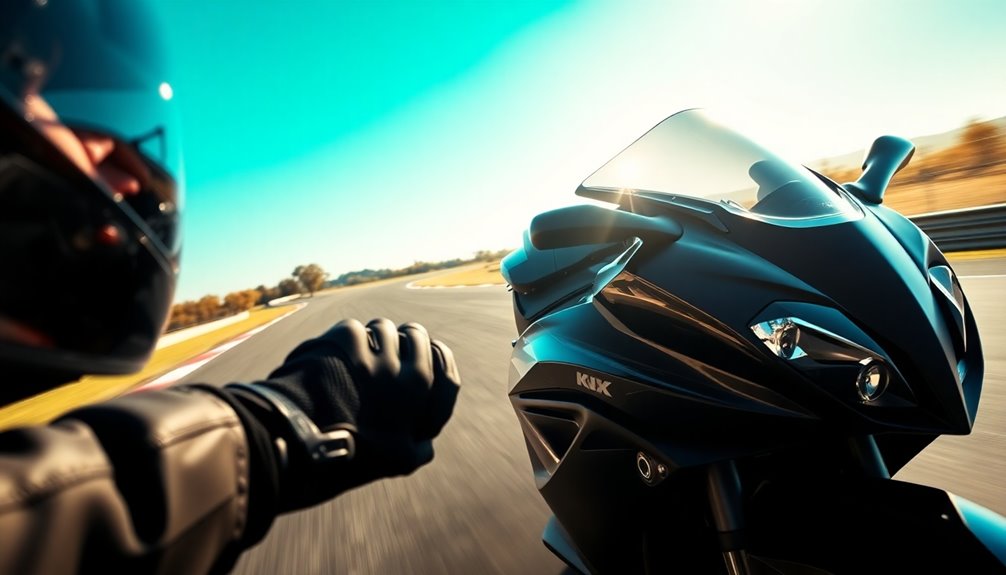
Riders often rave about the exhilarating acceleration offered by the Kawasaki H2 lineup, making it a standout in the world of superbikes. From the moment you twist the throttle, you'll feel the instant and forceful acceleration available in any gear, even at lower speeds.
The Ninja H2 impressively rockets from 0 to 60 mph in just 2.6 seconds, while the Z H2 isn't far behind at 2.91 seconds. As you push through the gears, acceleration remains fierce—hitting 0-100 mph in a mere 5.32 seconds with the Z H2. This performance is backed by a powerful 998 cc Supercharged engine, ensuring thrilling speeds on demand.
You'll appreciate the electronic throttle control, which ensures precise power delivery, making it easier to manage that raw power. When you engage Kawasaki Launch Control Mode (KLCM), you'll experience minimized rear wheel-slip and reduced front-end lift, allowing you to focus on the thrill of the ride.
Additionally, the high-performance suspension enhances traction and feedback, giving you confidence as you unleash the bike's full potential. Whether you're on the track or the open road, the acceleration of the Kawasaki H2 lineup is sure to leave you breathless.
Owner Insights: Performance Experiences
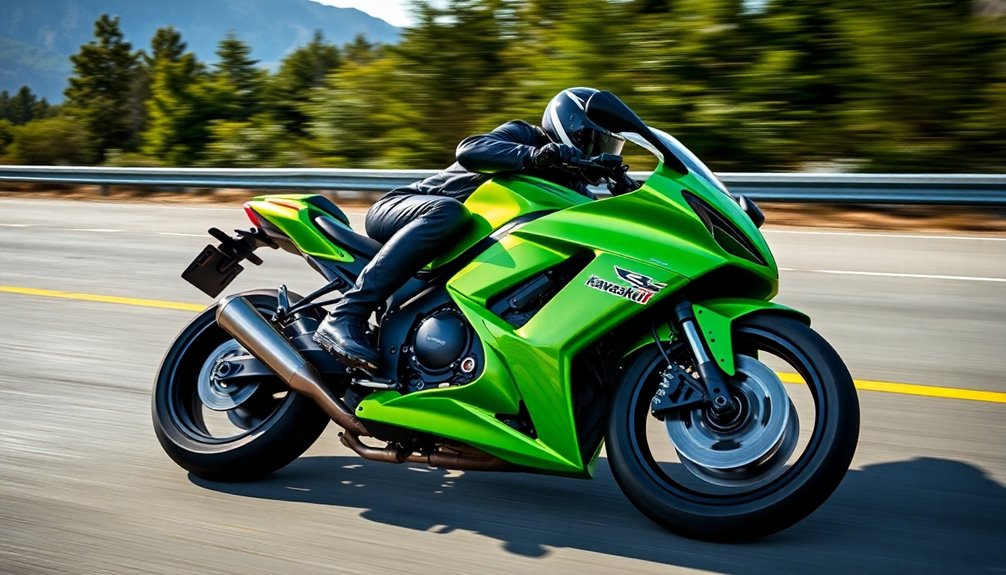
The thrill of acceleration on the Kawasaki H2 is just the beginning of what owners experience when they take to the road. With its 998cc inline-4 engine and variable-speed centrifugal supercharger, you'll feel an exhilarating surge of power, especially between 4000 and 8000 rpm. The progressive power delivery makes every ride exciting, while the dog-ring transmission ensures quick, precise shifts that enhance your control. Many riders have reported that they consider the H2 to be the finest motorcycle ever owned, reinforcing its reputation among enthusiasts.
When it comes to handling, the H2's ergonomics support an aggressive riding position, perfect for spirited rides. Although long-distance comfort can be a challenge, many riders find the smoothness of the ride compensates for the hard seat. Upgrading to Michelin RS tires can transform the bike's handling, making it feel even lighter and more responsive.
Braking is another highlight, thanks to the Brembo Stylema® calipers and advanced traction control systems that keep you safe at high speeds. While the bike's weight might seem heavy, it remains manageable, allowing you to navigate curves and straights with confidence.
Market Positioning and Rivals

While navigating the high-performance motorcycle market, the Kawasaki Ninja H2 series stands out due to its unique blend of luxury and power. Positioned in the high-performance segment, this series targets riders who crave both adrenaline and comfort. Its advanced technologies, like the supercharger and aerodynamic devices, enhance both performance and stability, reinforcing Kawasaki's reputation for innovation. The 998cc supercharged inline-four engine provides the H2 with an impressive power output that significantly contributes to its exceptional acceleration. Additionally, the use of data analytics in motorcycle performance has become increasingly important for optimizing ride quality and safety.
When you consider its rivals, the competition is fierce. The Ducati Panigale V4 offers impressive horsepower and track-ready tech, while the BMW M 1000 RR boasts advanced suspension and electronics. The Honda CBR1000RR-R Fireblade SP and Suzuki Hayabusa also command attention with their high-tech components and powerful engines. Don't forget the Aprilia RSV4 1100 Factory, another strong contender in this elite category.
Kawasaki's pricing strategy reflects its premium positioning, with the H2 and H2R priced at £22,000 and £41,000, respectively. These prices align with competitors, ensuring you're getting high value for your investment. With strong sales among enthusiasts and a global presence, the H2 series successfully attracts discerning riders who appreciate its exceptional performance and cutting-edge technology.
Performance Tuning Options
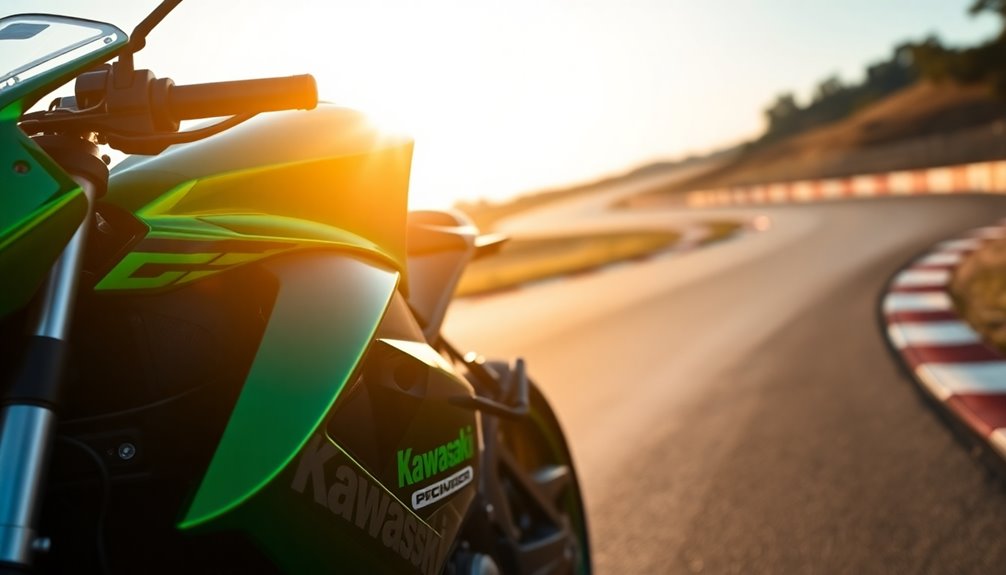
To maximize the performance of your Kawasaki Ninja H2, exploring various tuning options can unlock its full potential. One effective approach is upgrading the supercharger gears, such as installing Stage 4 gears to increase boost pressure and horsepower.
Pair this with an intercooler kit to lower intake temperatures, reducing pre-ignition risks and allowing for more aggressive tuning. You should also consider upgrading your fuel system with 1000cc upper injectors, a new fuel rail, and a fuel pump regulator to support higher outputs.
Adjusting ignition timing can further enhance horsepower, especially if you add a couple of degrees at high RPM. Additionally, forced induction systems outperform naturally aspirated bikes in tuning gains, making these modifications even more beneficial.
Don't forget about spark plug modifications; gapping them down to 0.45 mm can prevent breakdown issues with increased boost. For optimal fuel and air intake, swapping to a high-performance air filter can yield significant gains.
Using high-octane fuels like E85 allows for more aggressive tuning. Additionally, retuning the ECU is crucial after any modifications to ensure optimal performance.
Cost and Release Dates
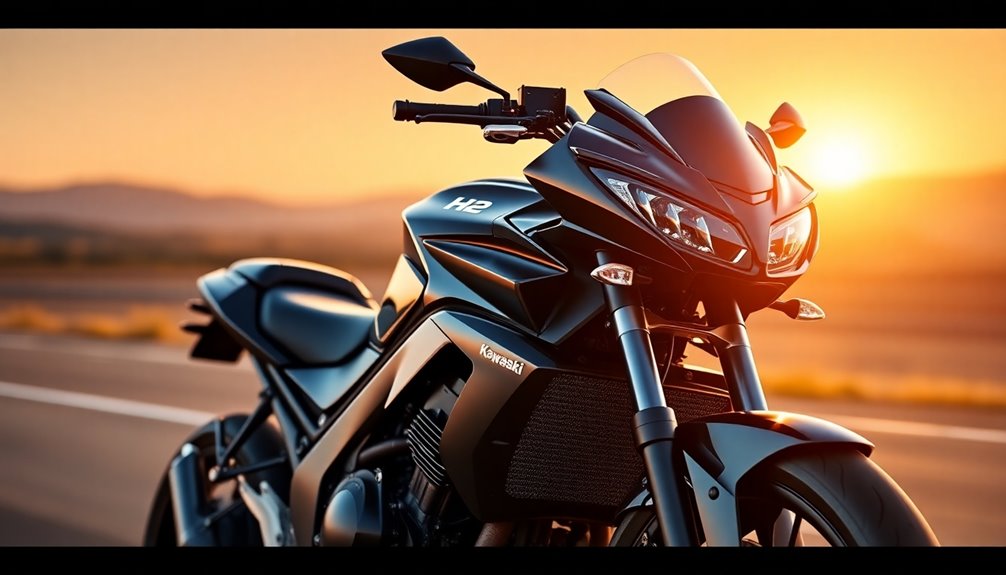
When considering the purchase of a Kawasaki Ninja H2, you'll find a range of costs associated with different models. The base model, the 2024 Kawasaki Ninja H2 ABS, starts at $32,100, while the Carbon version is priced at $35,600.
If you're looking for a more budget-friendly option, you might find used or older models starting as low as $17,999. However, keep in mind that prices can vary significantly based on condition and mileage, with the average listed price for various models around $37,490. For high-end or special models, you could be looking at prices soaring up to $59,100. Additionally, market analysis suggests that fluctuating demand impacts pricing for these models.
In terms of availability, the initial release of the Ninja H2 occurred in 2015, with new and improved models rolling out starting August 10, 2018. The 2024 models are currently available across global markets, including the United States, Canada, and Europe.
Special editions, like the limited-edition model from 2017, are produced in very limited quantities. Remember, for hand-built models like the Ninja H2 and H2 Carbon, you'll need to place a nonrefundable deposit to secure your order.
Performance-Focused Motorcycle Enthusiasts
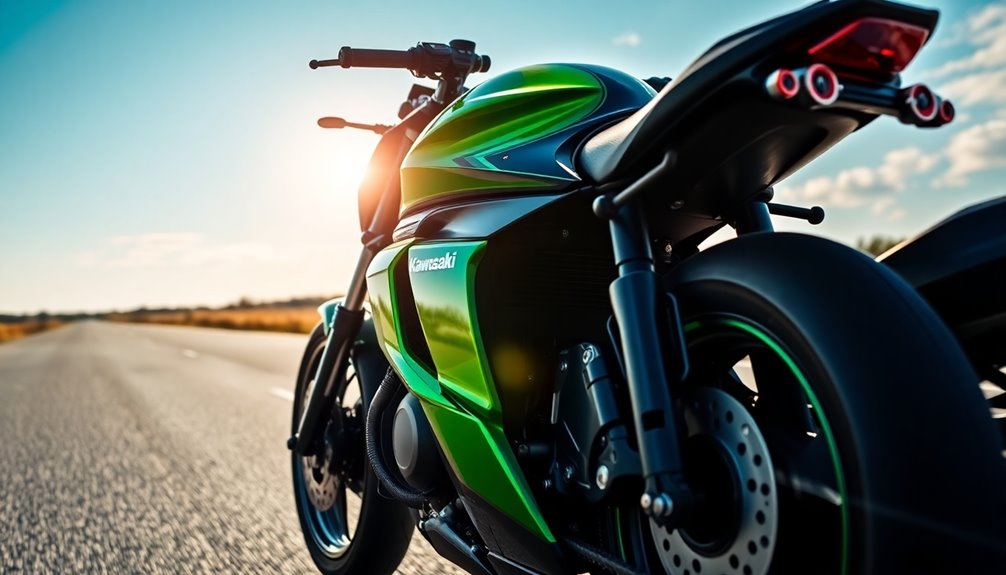
For performance-focused motorcycle enthusiasts, the Kawasaki Ninja H2 stands out as a pinnacle of engineering and speed. With a powerful 998 cc supercharged engine, it delivers an astonishing 310 PS at 14,000 rpm globally. This incredible power translates to a blistering 0-60 mph time of just 2.6 seconds, making it one of the quickest machines on the road. The H2 features a ground clearance** of 130 mm, which ensures suitable maneuverability for city commutes.
When you push the throttle, the H2's advanced ram-air assist enhances performance at high speeds, allowing you to achieve a theoretical top speed of 400 km/h. Even in tested conditions, it reaches 183 mph, and with aftermarket performance parts, you can potentially hit 226.9 mph.
The 6-speed manual transmission, featuring a quick shifter, ensures smooth gear changes, while dual-channel ABS and traction control enhance safety and stability.
You'll appreciate the riding modes tailored to different conditions and the launch control, which optimizes acceleration from a standstill. The H2 isn't just about speed; it's a finely tuned machine that caters to your desire for performance, pushing the boundaries of what a motorcycle can achieve.
Potential Mechanical Failures

Several potential mechanical failures can affect your Kawasaki Ninja H2, impacting both performance and safety. One major concern is the camshaft chain tensioner, particularly in models from 2015 to 2023. If the plunger locks up due to internal deterioration, your engine could stall unexpectedly, heightening the risk of a crash. A recall was issued to address this issue, affecting over 3,000 bikes.
Listen for any abnormal noises from the right side of the engine, as this could signal a problem.
Additionally, engine reliability issues tied to piston ring land breakage may arise, especially in SX models. High-performance riding can worsen these failures, so keep up with your major service intervals at 24,000 km and 36,000 km to maintain reliability.
Be cautious of potential supercharger and intake system issues as well. For example, bolts inside the air filter housing may not be threadlocked, risking damage to the supercharger impeller.
Always prioritize regular maintenance and heed any recalls, like the one issued for camshaft tensioner problems affecting over 3,000 bikes. Contact your authorized Kawasaki dealer to schedule recall services and address any concerns promptly.
Staying proactive can help you avoid serious mechanical failures down the road.
Safety Features and Technology
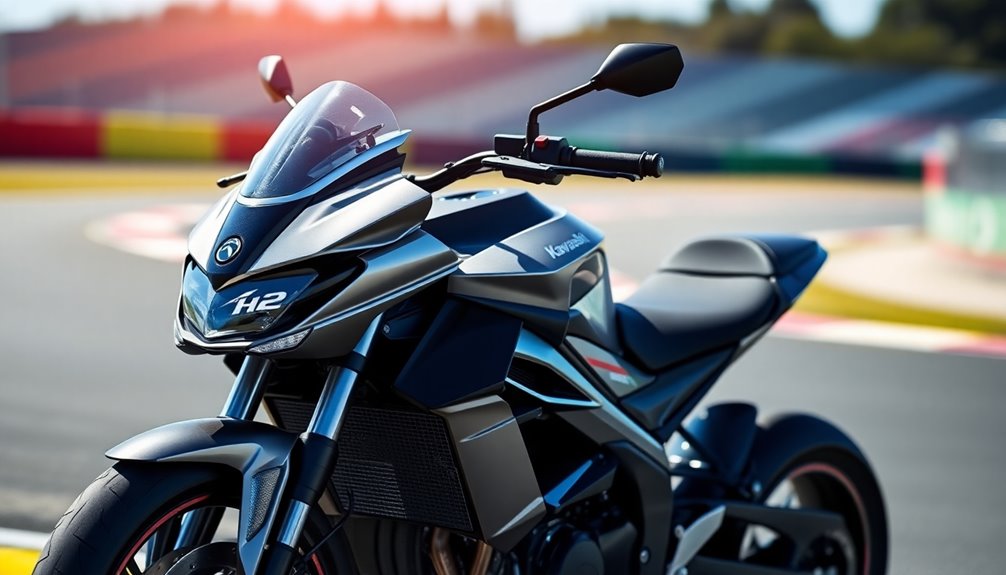
Maintaining your Kawasaki Ninja H2's performance and safety goes beyond addressing mechanical concerns; it also involves leveraging its advanced safety features and technology.
The H2 is equipped with top-notch braking systems, including the Kawasaki Intelligent anti-lock Brake System (KIBS) and dual radial-mount Brembo brakes, ensuring you stop efficiently and safely. With brake assist and specially designed front brake levers, you won't have to worry about wind force affecting your control at high speeds.
Traction and stability are paramount, and the KTRC offers superior grip in various conditions. The Kawasaki Launch Control Mode (KLCM) minimizes rear wheel slip during launches, while the slipper clutch reduces engine braking effects when downshifting. You can also customize your ride with various power modes. The maximum power output of 197.4 hp ensures that you have an exhilarating riding experience.
Electronic rider aids like riding modes and a contactless quick shifter enhance your riding experience. Plus, smartphone connectivity through RIDEOLOGY THE APP lets you access vital information and riding logs.
Don't forget about safety features like automatic headlights, an engine immobilizer, and optional anti-theft alarms, which boost your visibility and security. With these technologies, you're well-equipped for a safe ride on your H2.
Unmatched Speed and Handling
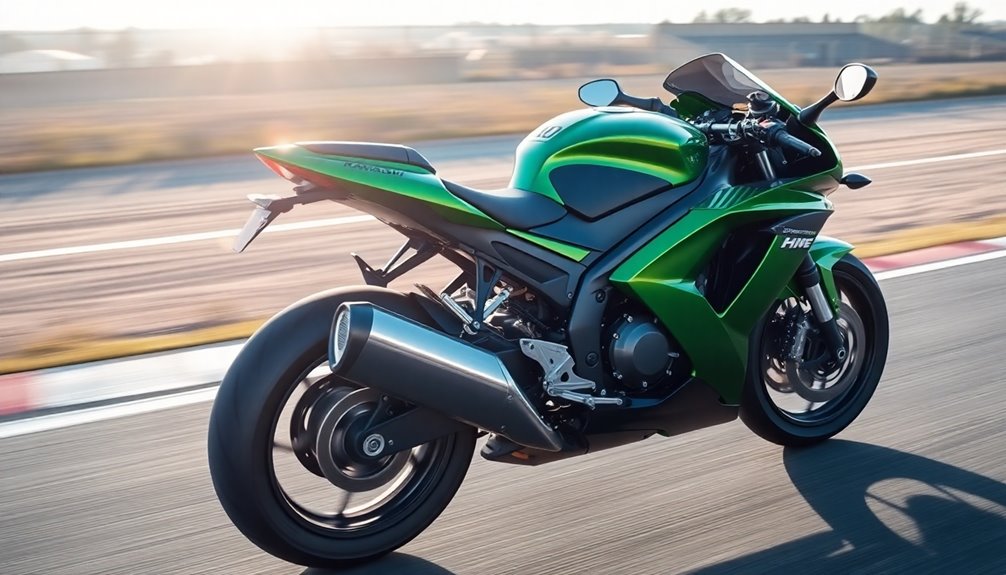
When you hop on the Kawasaki Ninja H2, you're not just riding a motorcycle; you're experiencing unmatched speed and handling that few machines can rival.
With a top speed of up to 322 km/h (200 mph) and acceleration that rockets you from 0 to 60 mph in just 2.6 seconds, this bike redefines performance. The H2R takes it even further, hitting a jaw-dropping 400 km/h (249 mph). Additionally, the H2 achieves a remarkable top speed of 226.9 mph, showcasing its engineering excellence.
But it's not just about sheer speed. The H2 features a robust trellis frame that offers exceptional rigidity, ensuring precise handling at high speeds.
The aerodynamic bodywork minimizes drag and enhances efficiency, while the high-performance suspension provides a smooth ride over any terrain.
You'll appreciate the stability afforded by the 1.46-meter wheelbase, and at a curb weight of 238 kg (525 lbs), maneuverability is effortless.
The supercharged 998 cc inline-four engine generates up to 200 hp, delivering exhilarating power without sacrificing control.
With all these elements combined, the Kawasaki Ninja H2 offers an unmatched experience that elevates your ride to extraordinary heights.
Frequently Asked Questions
What Is the Kawasaki H2's Fuel Tank Capacity?
The Kawasaki H2's fuel tank capacity is 17 liters, which is about 4.50 US gallons.
This design supports the bike's high-performance engine while ensuring you can enjoy longer rides without frequent refueling.
With its advanced engineering, you'll find that the fuel efficiency complements the power output, making it suitable for both street and track use.
How Does the H2 Compare to Previous Kawasaki Models?
When you compare the H2 to previous Kawasaki models, you'll notice significant advancements in power and technology.
The supercharged engine provides unmatched acceleration and efficiency, setting it apart.
You'll also appreciate the aerodynamic design and lightweight construction, enhancing overall performance.
The H2's electronic features, like cornering management, elevate your riding experience.
While earlier models excelled, the H2 truly redefines what's possible in a production motorcycle, offering a thrilling blend of speed and control.
What Are the Color Options for the Kawasaki H2?
The current color options for the Kawasaki H2 are quite limited.
You've got the sleek Mirror Coated Matte Spark Black as your only choice right now.
Unlike previous models that featured a variety of colors, there aren't any regional variations or limited edition options available for the current lineup.
Is the Kawasaki H2 Suitable for Beginners?
The Kawasaki H2 isn't suitable for beginners.
With its powerful 998cc supercharged engine producing 200hp, its abrupt throttle response can overwhelm novice riders.
Although it features electronic aids like traction control, these don't compensate for the need for experience.
You'll find its lightweight chassis and high-performance handling require skill to manage.
If you're just starting out, consider a less powerful bike before tackling something as intense as the H2.
What Maintenance Does the Kawasaki H2 Require?
To keep your Kawasaki H2 running smoothly, you've got to focus on regular maintenance.
Change the oil and filter as per the manual, and make sure you use the right oil.
Check chain tension and lubricate it often.
Inspect coolant levels, brake fluid, and clutch fluid.
Don't forget to monitor the supercharger and air filter.
Lastly, stay on top of checking brake pads and battery health to ensure peak performance.
